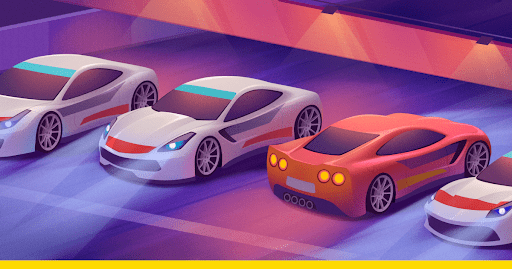The IoT is transforming the automotive industry for car manufacturers, fleet owners, drivers, and maintenance professionals. About 10 billion vehicles are already connected to the Internet, and 84 million of them are IoT-equipped cars. IoT sensors ensure uninterrupted production and help track the movement of vehicles, the technical condition of cars, and even the well-being of drivers. And this is not the limit yet. Let’s consider 5 cases of how IoT applications enhance the automotive industry.
ELECTRONIC data acquisition and processing tool
A European software development company, together with a business that configures Plug’n’Play digital support tools for automotive enterprises, has implemented ELECTRONIC, an IoT platform for data acquisition and processing.
The project integrates IoT sensors with a mobile platform. The manager of an enterprise attaches sensors to production equipment. Equipment performance information is collected and sent to personnel via a mobile app. The customer receives full analytics on machines. Moreover, if there are several similar devices, one can judge their serviceability by how much their performance indicators differ.
As soon as the IoT platform collects the right amount of data, machine learning is actively involved in the process. Based on the information collected, an AI algorithm learns to compare data and detect anomalies in the operation of devices. Thanks to this mechanism, the manager controls production in real-time. The specialist immediately notices any changes in the process and responds to them right away. With this knowledge, it is easier for customers to evaluate equipment performance and manage production. This IoT tool for handling industrial data guarantees revenue growth by an average of 16%.
Source: andersenlab.com
Ellis-Car fleet management solution
The IT company Andersen partnered with a French customer to implement Ellis-Car, a solution including an application for fleet owners and a platform for drivers. The founders of Ellis-Car discovered that 90% of accidents on the road are due not to external factors but drivers’ errors. Therefore, they decided to use the power of AI, Big Data, and the IoT to create a digital platform that can protect people and the world around them and boost business development.
The business part of the IoT application is a fleet monitoring platform. Connected sensors collect data about each car and transfer it to the manager’s information panel. A specialist sees the performance of an individual driver or a fleet team. Every week, employees receive a report on the activity of drivers: earned points, information about saved fuel, carbon emissions, mileage, and so on. In this way, the owner can change the behavior of workers on the road and reduce fuel costs.
Another component of this IoT platform “takes care” of drivers’ safety. The AI algorithm evaluates the situation on the road and warns drivers if there are obstacles or traffic jams on the way. It tells them when to slow down and reminds them not to use their smartphones while driving. The application saves driving data and recommends what points one needs to improve to increase their driving level and rating.
Source: andersenlab.com
Hitachi Construction Machinery: heavy machinery fleet management
This heavy machinery management IoT platform monitors over 300,000 vehicles in 140 countries. By using connected sensors, construction crews and equipment suppliers analyze fleet performance.
Employees monitor the condition of equipment, its location, operating time, fuel consumption, and power. Thus, they find problems in advance and fix a car before it breaks down. This reduces downtime and unplanned interruptions.
The data that the platform collects helps professionals use work equipment efficiently, reducing time and costs. This is especially important for remote areas where it is difficult and expensive to ship replacement parts. Car rental companies use the IoT platform to better plan and improve operations with heavy vehicles.
Source: hitachicm.com
Active Suspension Control – BLE for fitting the air suspension
IoT technology also supports software solutions for individual use. One such example is the Active Suspension Control BLE platform for active control of the air suspension with the help of a smartphone.
The owner of a car can lower or raise the suspension when they encounter potholes, pits, or other irregularities on the road. The user sets the shutdown speed when the vehicle needs to return to the standard height or maintain the set height. More than 10,000 people use the convenient adjustment function to ensure a comfortable ride on any terrain.
Source: play.google.com
Dash IoT solution for car diagnostics
Dash, a New York-based company, has created a combination of an OBD device and a mobile application that resembles a smartwatch. After installation and setting up the equipment, the application begins to collect information about the movement of a car and its performance. So, the platform records trips in a log, maintains statistics on fuel consumption, defines the type of driving, and performs many other useful functions.
For example, the application informs a driver about possible obstacles or threats on the road. It recommends at which gas station fuel prices are cheaper. The driver notices when their car has technical problems and warns of an upcoming repair. The application even offers a list of mechanics who can fix the car, ranking them by rating and reviews.
The platform not only ensures road safety but also teaches smart driving and economy.
Source: dz-techs.com
Conclusion
The above use cases of the IoT in the automotive industry demonstrate how a business can evolve using this technology. Connected cars and production equipment with IoT sensors are considered a must for development and competition. The IoT is changing attitudes toward a car, which is becoming a convenient “mobile device” rather than an indicator of someone’s social status and independence. It serves people and will soon change the economy, cities, and our everyday life. So, this is a new surprising and delightful reality.
